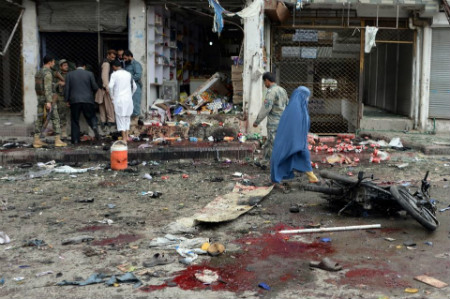By Heath Druzin
KABUL, Afghanistan — Security in Afghanistan is deteriorating, violence is increasing, and the Islamic State has become “operationally emergent” in the country’s east, though insurgents have not been able to exert lasting control over any major population centers, the Pentagon says in a new report.
The document, titled “Enhancing Security and Stability in Afghanistan,” comes as a crucial time, as it assesses the Afghan forces and the Taliban in the past summer fighting season, the first time coalition troops were largely absent from the battlefield.
“In their first fighting season against an Afghan-led counterinsurgency, the Taliban-led insurgent threat remains resilient,” says the report, which looked at the period from June 1 to Nov. 30. “Fighting has been nearly continuous since February 2015.”
The Afghan forces, which the U.S. funds at more than $4 billion annually, took a record casualties at a record rate, which could have been partially mitigated through better equipment and medical evacuation capabilities, the report says. The Taliban also suffered heavy losses.
“We said from the beginning that this was going to be a tough year,” said Col. Michael Lawhorn, spokesman for the U.S. military coalition.
While violence is up around the country, high-profile attacks in the capital, Kabul, saw a dramatic rise, by 27 percent over the same period in 2014, according to the report. Afghan attitudes about their own security are concurrently becoming more pessimistic: The report found that only 28 percent considered security in their area to be good, down from 45 percent in 2013.
“The (Afghan security forces) are generally capable and effective at protecting the major population centers, or not allowing the Taliban to maintain their hold for a prolonged period of time,” the report says. “At the same time, the Taliban have proven capable of taking rural areas and contesting key terrain in areas such as Helmand while continuing to conduct high-profile attacks in Kabul.”
Echoing recent statements by military officials, the report found that logistics, air power and operational planning to be major shortcomings of the Afghan security forces. It criticized them for being too focused on checkpoints and unable to hold territory once they regain it.
“What we’d like to see them do is come off the checkpoints a bit and be more mobile,” Lawhorn said.
Gen. Dawlat Waziri, spokesman for the Afghan Defense Ministry, rejected the assertion that the Afghan military is too reliant on checkpoints, saying that between Tuesday and Wednesday alone there were 13 operations in 12 provinces. He also said it was unrealistic to expect Afghanistan’s stretched forces to hold every scrap of the largely rural, mountainous country.

A burqa-clad Afghan pedestrian walks past security personnel at the site of a suicide attack outside a bank in Jalalabad on April 18, 2015. (Photo: Noorullah Shirzada/AFP)
“Afghanistan has 34 provinces and about 400 districts, so we can’t put checkpoints or military posts everywhere in the country to secure the area,” Waziri said.
Afghan forces still lack significant close air support — considered a vital element of any counterinsurgency strategy — though the nascent air force has increased its operations this year. The report found that the service continues to struggle to complete basic maintenance and procure spare parts for their aircraft.
Another persistent problem the report highlights is a high rate of desertion among the Afghan rank and file.
While the report focuses on the ability of Afghan security forces to fight the Taliban, it says that peace talks would be the most effective way to end the war.
“The U.S. and Afghan governments agree that the best way to ensure lasting peace and security in Afghanistan is reconciliation and a political settlement with the Taliban,” the report says. “Success of an Afghan led peace process will require the Taliban and other armed opposition groups to end violence, break ties with international terrorist groups, and accept Afghanistan’s constitution, including its protections for the rights of women and underrepresented groups.”
The report identifies the Islamic State group as an emerging threat in the country, citing two recent attacks, one on a U.N. vehicle and another on Afghan forces. A Stars and Stripes reporter recently witnessed fighting between Afghan troops and Islamic State fighters in the eastern province of Nangarhar.
“U.S. and (coalition) leaders will continue to monitor the potential threat of an established (Islamic State) presence in Afghanistan,” the report says. “The Afghan government is particularly concerned about the rise of (Islamic State), which they see as a serious looming threat in the region as part of what President (Ashraf) Ghani has referred to as the “ecology of terror.”
Buried deep in the 96-page report is the news that the Afghan government will almost certainly miss the 2024 deadline set by donor nations at the 2012 Chicago Summit for the country to fully fund its defense. Currently, donor nations contribute about $5 billion to security forces, while the Afghan government provides about $400 million.
Between the main train, advise, assist mission, known as Resolute Support, and the smaller counterterrorism mission, there are about 17,000 foreign troops in the country, the vast majority of them the roughly 10,000-strong U.S. contingent.
Zubair Babakarkhail contributed to this report



